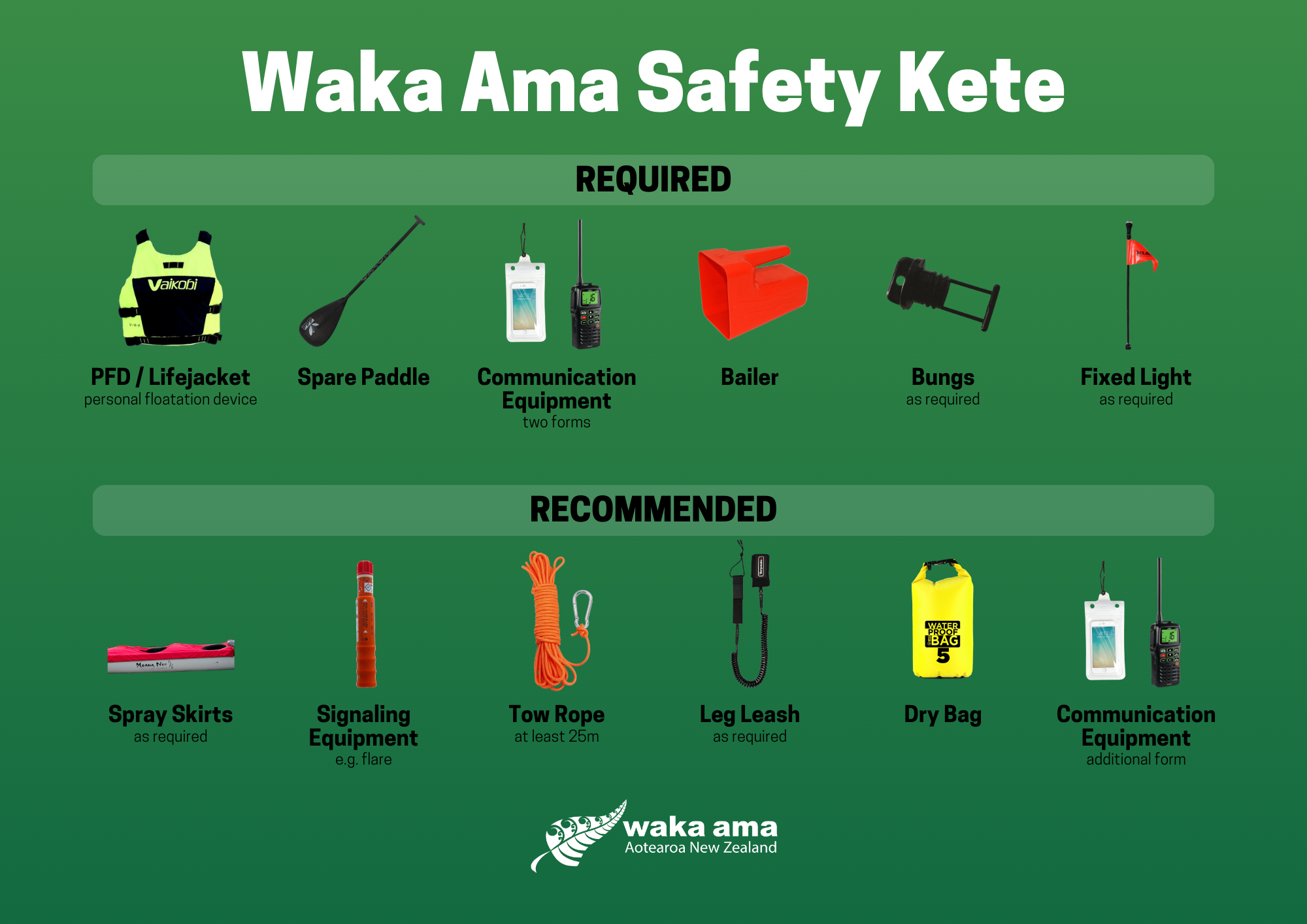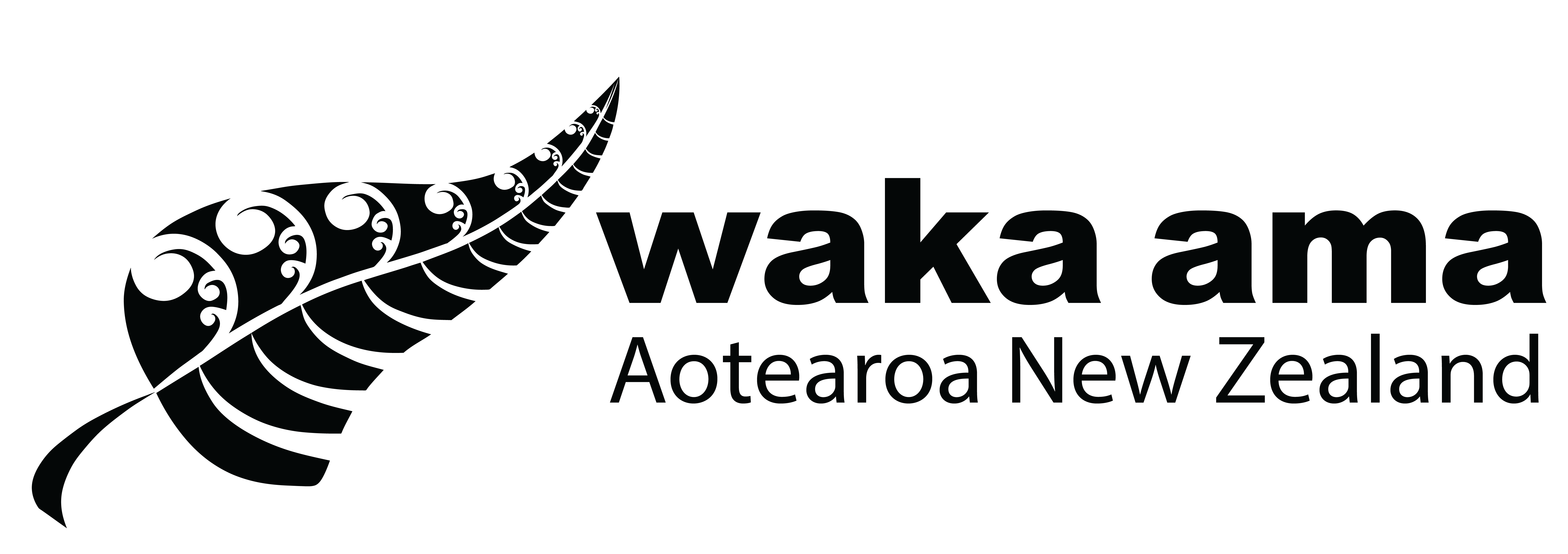Waka Ama Safety Kete
Having the right equipment when out paddling is vital to staying safe on the water. Make sure to having the following equipment whilst out paddling (at a minimum) and any other relevant safety equipment.
Required Waka Ama Safety Gear
Under the Navigation Safety Rule (part 91) and navigational safety bylaws everyone on a vessel, and that includes Waka, is required to have available an appropriate and correct fitting PFD, and that it should be worn at times of heightened risk such as rough seas, strong ocean currents and open waters. Most paddlers use some sort of recreational buoyancy vest which will not impede paddling, or climbing back onto their craft. However it is important to understand that a buoyancy vest, unlike a lifejacket, may not support an unconscious person face up in the water.
PFDs are essential for novice and junior paddlers.
- Be in excellent condition
- Have the correct buoyancy rating for your weight
- Be the correct size for your body
- Be fitted properly. This usually means correctly fitting shoulder straps (some are adjustable) and firmly adjusted chest and waist fastenings. A common fault is wearing a PFD too loosely which means that when you are in the water the PFD rides up above your shoulders leaving your nose underwater
- Be accessible
It is important to carry a spare paddle incase your paddle gets broken or floats away whilst out paddling.
A very brief message to all craft in the area on channel 16, stating that you are on the water, can alert others to your presence.
If your waka has bungs, it is important that they are done up and used whilst paddling. This will keep your waka air tight.
At times of low visibility, it is the law that all craft must be visible on the water from all directions (360'). The light must be at least one meter high above the waka and not be flashing - it needs to be a static light.
-editajbdubq-4hgx8o.png)
Recommended Waka Ama Safety Gear
A dry bag will help keep all your essential items, especially your forms of communication, dry. Ensure the bag is secured to the waka in a suitable place so that (if) your waka flips you don't lose your equipment/bag.
A very brief message to all craft in the area on channel 16, stating that you are on the water, can alert others to your presence.
Cell phones are restrictive in that they are only heard by the person dialed and have limited ‘coverage areas’. If you have a cell phone, of course – take it with you, but always keep it in a waterproof bag.
-editrrahmnb-k3dfj7.png)
Other Equipment
- Water bottle/energy snacks: If you are paddling any distance you need to keep well hydrated. You can use an ordinary water bottle, but make sure it is tied onto your Waka. Most paddlers use a backpack drinking system for long distance paddling. Energy bars or similar can also provide nourishment.
- Knife: A sharp knife can have many uses from freeing yourself or others from entanglement, to fishing.
- Survival kit: On a serious trip paddlers should carry a small bag containing survival gear that they can grab if they get washed onto some remote shoreline. This can contain first aid gear, an emergency blanket, emergency shelter, fire lighting equipment, energy food.
- First aid kit: A small, basic first aid kit should be carried.
Waka Visibility
There are many factors that can prevent boaties from seeing waka and other craft that sit low in the water. Conditions such as choppy water, fog, glare, sun strike, rain, wind in the eyes, salt spray on the windshield, poor vision or a combination of any of these can affect a boaties ability to spot a small craft in the water. Waka ama paddlers and others using similar craft can do a lot to dramatically improve their visibility – and therefore their own safety.
- Wear a bright fluro hat: Your head is your highest point – make it as bright as possible. Day-glow orange or yellow hats are highly visible.
- Blazing paddles: Motion is another important visibility tool. Because your hoe (paddle) is in constant motion while paddling, you can increase your visibility by using reflective tape on blades or shafts, in combination with strips of day-glow tape.
- Fly the flag: Day-glow orange and yellow chopper flags provide a permanent bright flash at a good height above the water. Chopper flags ‘break the horizon’ of other vessels and draw attention to the waka.
- Colourful craft: Choose a waka in a bright, contrasting colour.
- Dress to impress and protect: Wearing a day-glow orange or yellow paddle jacket or over shirt offers the highest visibility potential.
- Warm, dry clothing: Effective clothing for paddlers in winter is a top made of polypropylene (or similar synthetic fibre), plus a waterproof wind shell as necessary.
- Stay together: If you are paddling with others, stay in close range of each other
See the attachments on this page for a downloadable copy of the Waka Ama Safety Kete poster.

